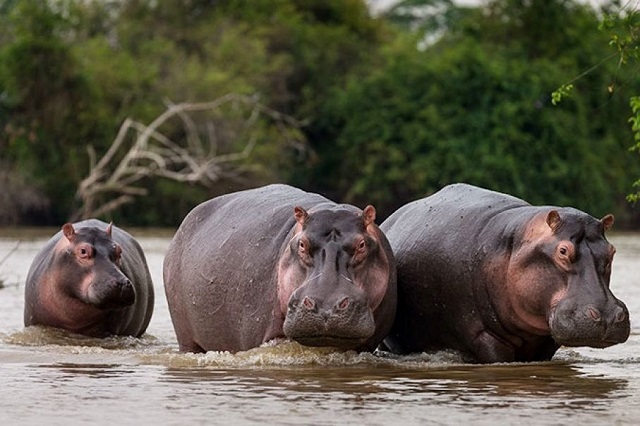
Kiryandongo, Uganda | THE INDEPENDENT | Uganda’s stringent law against poachers has remarkably impacted the butcher of elephants and hippos for their teeth and tusks.
However, there has emerged a concern that local poachers are still killing the iconic hippos, and thereby threatening the country’s ecosystem and the tourism sector.
The common hippopotamus is the third largest and heaviest land mammal after elephants and white rhinos found in Uganda’s national parks. Their killing for meat other than their teeth has particularly been observed in the Murchison Falls National Park.
The Murchison Falls National Park hosts an estimated 3,000 of Uganda’s 10,000 estimated hippo population.
“We are losing our hippos at a dramatic rate. It is a massive issue; our hippos are being targeted. It is one kill, one large animal to butcher and move. It is not like chasing after four Uganda kobs in the savannahs where the rangers can see you” says,” says Michael Keigwin, the founder of Uganda Conservation Foundation (UCF), whose charity has worked with Uganda Wildlife Authority to boost conservation and anti-poaching efforts.
According to Keigwin, despite their massive weight, they are easily killed. He told URN that the search for profits is one of the major reasons why they are targeted more than before.
“Whatever people are eating there is a zoonotic disease problem. Everybody has been told this again and again. But to some people, the trade in bush meat doesn’t care about the reality. What they care about is the money. And for hippo, it is one kill, a lot of money, a lot of profit,” explains Keigwin.
“It is devastating for the country. You remove tourism revenue; how many jobs are you removing here? I will tell you one million” adds Keigwin who has embarked on efforts to raise funds to support hippo conservation projects through fundraising and capacity building.
Poached with Snares
The Uganda Wildlife Authority has observed so much poaching using snares made from locally collected electric wires including those extracted from motorcars and motorcycle tyres.
John Wilembe, a store clerk with Uganda Wildlife Authority told URN they are increasingly seizing snares and wheel traps in Murchison Falls National Park.
Tons of so-called bear traps or snares used by poachers to trap elephants, hippos, and lions were buried in the foundation of the office block where Wilembe’s office is. The idea was that those would not end up in the hands of the poachers again.
But again, the “snare mountain” or pile of those traps confiscated from poachers is piling almost covering half of the room in which they are kept.
Wilembe expects many more traps to end up in the park because materials for making them are easily available in communities. The extension of electric power lines to the West Nile has particularly come with the influx of new and stronger electric wires either stolen or bought from workers.
On the other hand, wheel traps are sourced from garages in the districts neighboring the national park. Artisans specialized in making the traps and the spears continued unfettered.
“We have two types of speakers used by the poachers. Spears with wooden handles are strictly used by the Alur from West Nile, and then those with wooden handles are used by the Acholi” says Wilembe.
“The law of Uganda cannot be used to arrest them, if you get somebody with a wheel trap in his compound, you cannot arrest him. The government has to change the law,” suggests Wilembe. A wheel trap costs about three hundred thousand shillings.
Recently, special traps have been made to target hippos whether in the water or while ranging in the savannah. Asked why hippos are targeted, Wilembe explains “Hippos are being targeted because once you kill a hippo, you can get much more money than other small animals. And then, hippos move mostly at night close to the communities”
Michael Keigwin notes there is too much poaching with snares in the different sectors of the parks. “We have to stop the dumping of car tyres in this country. Where the car wire becomes a trap” says Keigwin.
Murchison Falls National Park has had one of the largest concentrations of hippos. The biggest concentration of hippos could be found at the hippo pool along the River Nile.
Visitors were usually told that the best time to see the hippos was during the dry season from June to September and November to December. Some have been to the hippo’s pool but have not seen any. Some tour operators suggested that some of them might have migrated to DRC.
URN interviewed Fredrick Kiiza, the Chief Warden of Murchison Falls National Park few meters away from the Nile Delta where the Hippos pool. It was close to midday; no hippo was spotted in the vicinity. He explained that the majority of the communities across the Nile out of the park boundary used to survive on Wildlife.
“Our neighbors come from community land. The majority of them like the meat of the hippo. So we have had to deploy the marine patrol to save the remaining animals,” says Kiiza.
Kiiza does not entirely agree that the hippo population here is on the decline. “Because this is nature and this is not a zoo where the hippo pool must remain the same. We are having climate change. When we look at the ecosystem, it used not look the way you see it,” says Kiiza.
“So when you do a proper science, you will understand why hippos migrate. However, hippos have been poached but not to such dangerous levels that cause alarm. With continued marine patrols, the numbers are going to increase,” he says. Despite his disagreement, Kiiza agrees some poachers are turning to the marine animals. He says two things could be happening.
“There is no save zone in the park for the poachers. It is very risky for you to enter the park. Hippos are in the water, today they may be here and they will migrate. But there is also an open market for game meat across in Congo and that has been our problem” he explains.
It has been hard to find verifiable and researched information about the extent of the decline in the hippo population in Uganda.
UWA’s Director of Field Operations, Charles Tumwesigye was quoted saying that ranger reports and an aerial survey indicated that hippo numbers have dropped. Keigwin has indicated about 60 percent of the hippos at Murchison have been poached during the recent years.
A conservationist with one of the conservation groups in Uganda who asked for anonymity told URN unlike other animals, hippos have received the attention they deserve in terms of the threat to their numbers and threats to their ecosystems.
“There is no doubt that hippos are being hunted, their habitats have been destroyed. Even if lose just five hippos in a month or year in the entire park, it takes many years to replace them”
Studies have found that hippos are vulnerable to over-exploitation due to their very low reproductive output. It has further been established through modeling that even an offtake of 1% of adults can lead to a high probability of population declines over 30-40 years.
Hippos produce one offspring every other year and have a gestation period of eight months, a lactation period of 12 months (but can be 18 months or longer), and a generation length of 10 years. What do we lose when hippos go extinct?
Asked why we need to conserve hippos, Kiiza says “That is a good question. Because they are in the food web because they are in the food cycle of the marine ecosystem. Kill all the hippos, there will be no fish in the water” It has been documented that hippo declines in the River Nile and the Lake would have a knock-off effect for other on other for other species in those water bodies.
“Hippos leave the water, come on the grounds, graze many kilograms of grass, they go back in the water and shit there. In other words, they take food for the fish” says Kiiza.
Some have said hippos act as the ‘glue’ that holds habitats together. It has equally found that while grazing, hippos create “grazing lawns” of grass good for other grazing animals in the national parks and that they play a critical role in deterring bushfires.
Worried about falling hippo numbers, Uganda banned the trade in hippo teeth. But hippos have been losing their habitat and continue to be poached for meat. While some countries have registered incidents of trade in hippo teeth and skin, carcasses of hippos have been found with some of those parts intact meaning that they are not the reason hippos are butchered.
“They (poachers) often leave the bones and teeth. They take other pieces of flesh” explains Keigwin.
What can be done?
Keigwen says so long as there is poaching and UWA is not resourced enough in terms of personnel and technology to recover those resources, there is always going to be a struggle. “Why can’t we put a dollar into community development programs? Which could be scholarships. We are having to spend a dollar in preventing people come in” he says “I prefer having that dollar in people for scholarships for education. Because UWA has done a good job they need to continue doing that”
One of the top rangers has indicated to URN that UWA has far fewer than the recommended number of rangers in all the parks.
He suggests that Ugandans should learn from Kenya where more than 75% of the wildlife is outside the national parks. “People have an affinity, they have jobs, they are involved in tourism, they have care. Many Ugandans have totems but gradually that is eroding in peoples’ thoughts”
******
URN
 The Independent Uganda: You get the Truth we Pay the Price
The Independent Uganda: You get the Truth we Pay the Price



